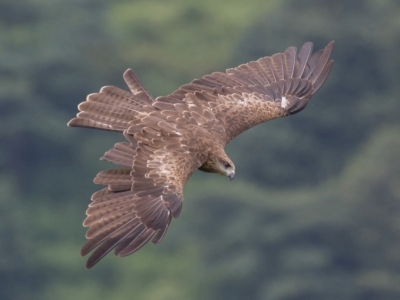
The black kite, or Milvus migrans, is a medium-sized raptor from the family Accipitridae. It has a predominantly brown plumage with a paler coloured head and neck. It has a part black and part yellow bill, dark brown eyes, pale yellow leas and long black talons. These kites are sometimes called fork-tailed kites because their tail feathers are split, forming a v-shape. The outer edge of their wings appears to be ‘fingered’ because of individual feathers which look like fingers. Females are slightly larger than males. This species is found in Europe, Asia, Africa and Australia. The birds living in temperate areas tend to be migratory, while the birds living in tropical areas are permanent residents.
Although these birds have a large range of habitats, they prefer open areas with access to water bodies like rivers and lakes. They eat fish, reptiles, amphibians, rats, bats and sometimes carry off chicks from other nests as food! They are opportunistic hunters and will scavenge for food in rubbish heaps and urban sprawls. They are good communicators and have a shrill, whistling cry – ‘kleeee-errr’ which is followed by a rapid whinnying call – ‘keee-keee-keee’.
Black kites usually build their nests in trees or ledges in cliffs. They use paper, feathers, sticks and even plastic to line the nests and make them soft. The female lays 2 to 3 off-white eggs freckled with brown spots. The incubation period averages 32 days and chicks are cared for by both parents.
Two subspecies of black kites are found in the Indian subcontinent- the black-eared kite and the small Indian kite. The black eared kite is found in the Himalayas and northern parts of India and the small Indian kite is seen in eastern Pakistan, east through tropical India, Sri Lanka and the Malay Peninsula. The black kite is supposed to be the most abundant species in the family Accipitridae. This is because it covers a large region and has a large population in these areas. It is listed under ‘Least Concern’ in the IUCN Red list.
Picture Credit : Google




